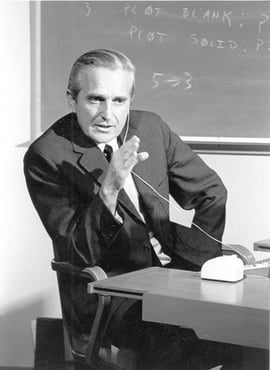It was 1994, another regular day at the office, or so I thought…
I walked into the break room at Logitech HQ to warm up my lunch. An older man I hadn't seen before was sitting at the table. I walked up and introduced myself, and he told me his name was Douglas.
I told Douglas I was a Tech Support guy, and asked him what he did for Logitech. He looked at me kind of funny and then said:
“I’m a product designer and inventor”
I was interested. Inventors and product designers are typically creative, and strive to solve real problems with innovative solutions. I asked him how he got into that line of work. He replied:
“Well, I invented the pointing device and work with Logitech on design concepts. We’ve been working on getting rid of those pesky metal rollers and moving our devices to an optical design with no moving parts at all”
 My mind raced. I was in the presence of Douglas Engelbart, an absolute legend in the early days of personal computing. He was the inventor of the computer mouse and an early pioneer in internet technology.
My mind raced. I was in the presence of Douglas Engelbart, an absolute legend in the early days of personal computing. He was the inventor of the computer mouse and an early pioneer in internet technology.
I searched for something to ask him. Surely there was a nugget of wisdom I could get from this guy. After a few seconds of silence which seemed an hour long, I finally asked:
“What made you come up with the mouse?” It was the best I could do at the time.
His answer stunned me.
“The biggest problem we had with computers was that they weren’t accessible or usable for non-technical people. My work on the pointing device was about making it easier for human beings to interact with technology, because humans need to solve problems more quickly than ever. Technology should augment that, not get in the way.”
Douglas said the above with no hubris. He meant what he said, and obviously loved what he did. I think I stood there for 20 seconds with my mouth wide open. He looked at me all the while, and then chuckled and said, “I get that a lot when I talk about the why.”
This brief interaction completely changed my perspective on helping customers fix their pointing devices. Looking back, I learned three critical things that day:
- Customers are not an obstacle - they’re the lifeblood of my business and I should work hard every day to give them the best experience possible
- A new customer is not a revenue output - it is a new relationship that I should nurture as best I can
- I should work hard every day to make it easier to do business with my company, no matter my job title or company goals
The daily grind turned into a new career passion for me. I spent the rest of the day cracking dry jokes while solving customer problems. I got faster and felt less burned out. Most importantly, the strangers I was talking to on the phone (my customers) noticed, and those interactions trended more positive over time.
That lunch room chat turned into weeks, months, and now a couple of decades of inspiration from this brief interaction with Douglas.
I recount this story because I see this philosophy in play every day here at Avast Business. I sit less than 100 feet from our Sales and Technical Support teams and they are invariably energetic, happy, and truly enjoy helping customers. We see customers as a relationship that requires effort to maintain, instead of numbers on a P&L statement.
I’m willing to stake my career philosophy on this.
If you ever need to get in touch with anyone at Avast or Avast Business, fill out our Contact Us form.
If you are looking to purchase, looking for more information, can’t get a hold of us, want to provide product feedback, or just need a little help. Our team views and processes these inquiries in 24 hours or less, and if they don’t know the answer, they will find someone who does.
Further, feel free to contact me personally via my LinkedIn profile if you have any feedback to share. Just click on my author name above and you’ll find a LinkedIn button that leads right to my profile.
My colleagues and I look forward to hearing from you!
.png)
